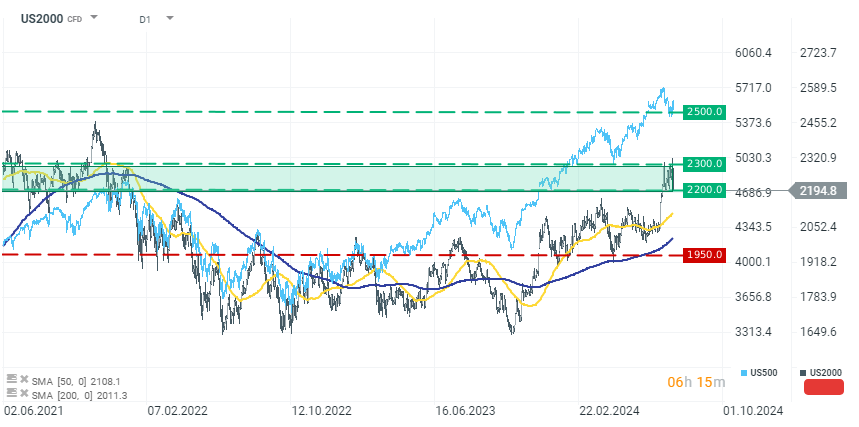We observe a slightly panicked sell-off on US stock exchanges after the publication of weak ISM data and jobless claims in the USA. The biggest declines are noted in the small-cap index, US2000, which loses 3.40% below 2200 points.
Investors have not yet fully priced in yesterday's FOMC decision and Jerome Powell's speech, and today they receive more very important ISM data. However, the excitement doesn't end there, as Amazon and Apple will publish reports after the session today, and tomorrow we will get key data from the US labor market - the NFP report.
-
So far, after worse macro data from the USA, the market reaction has been paradoxically positive because it increases the chances of faster interest rate cuts by the Fed. However, now in the face of an almost certain cut in September, the market perception is slowly starting to change.
-
Until now, the market has priced in a soft landing scenario, but after a series of increasingly weak data, the key question remains how likely such a scenario still is. At yesterday's conference, the Fed mentioned the dual mandate for the first time in a long time, which means the weakening labor market is gaining importance in future decisions.
-
Today's ISM data increases the likelihood of cuts, and further weaker labor market data confirms the further slowing of the US economy. Key July data will be revealed tomorrow in the NFP report.
Today's panicked sell-off in the market is a manifestation of growing uncertainty among investors who are currently trying to price whether a no-recession scenario is possible. The market reaction has most affected small-cap companies. On the one hand, this is due to relatively large increases in recent weeks. Currently, the index has erased the gains of the last two weeks. On the other hand, if the US economy falls into a slowdown period, smaller companies, which are already in worse condition after a period of high-interest rates, will be hit the hardest again.
The US2000 index is currently testing the lower boundary of the recent consolidation range at 2200-2300 points. If the bears manage to break below it, we can expect to erase the remaining gains after the lower CPI report from the USA in mid-July, to levels around 2050 points. Otherwise, it will be crucial for the bulls to maintain the consolidation zone above 2200 points.

Source: xStation 5
ข่าวเด่นวันนี้: Wall Street ปิดสัปดาห์ด้วยกำไรเล็กน้อย 🗽 ขณะที่คริปโตเคอร์เรนซีปรับตัวลดลง
3 ตลาดน่าจับตาสัปดาห์นี้
US100 พุ่งขึ้นหลังตัวเลข PCE 📈
Santa Claus Rally — แค่ตำนาน ตัวเลขสถิติ หรือโอกาสทำกำไรจริงในปี 2025?


